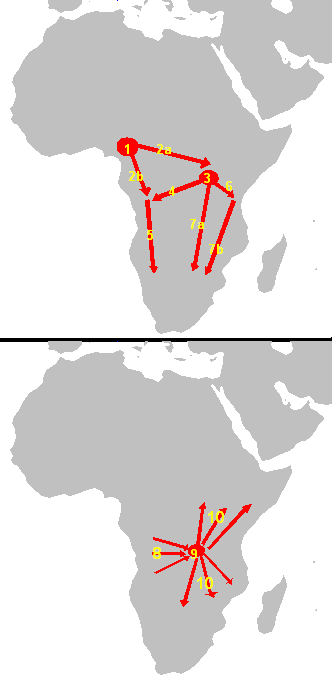While the civilizations of the Nilotic area were prospering and developing, around 2000 BC or 1500 BC, the first Bantu migration to the tropical forests of Central Africa began, from a location in the southeast of present-day Nigeria and Cameroon. This was likely caused by demographic pressure from Saharan populations fleeing desertification. The second phase of migration, about a thousand years later, around 1000 BC, brought them to southern and eastern Africa. The Bantu, who were breeders and semi-nomads, migrated southward, where they both mixed and clashed with local hunter-gatherer populations. Their movement continued until they reached the region inhabited by Khoisan-speaking people in southern Africa. These events explain the ethnolinguistic map of present-day Africa.
Area of Bantu languages.
1 = 3000–1500 BC, origin
2 = approx. 1500 BC, first migrations
2.a = Eastern Bantu, 2.b = Western Bantu
3 = 1000—500 BC, Urewe, the core of Eastern Bantu
4–7 = advance south
9 = 500 BC—0, Congo core
10 = 0—1000 AD, last phase147.
For more information :
- https://fr.wikipedia.org/wiki/Portail:Afrique
- https://en.wikipedia.org/wiki/Africa
- https://africacenter.org/
- https://journals.openedition.org/etudesafricaines/
- https://etudes-africaines.cnrs.fr/
- https://journals.openedition.org/etudesafricaines/
- https://www.afdb.org/fr/documents-publications/economic-perspectives-en-afrique-2024


